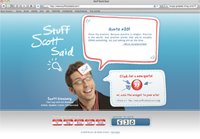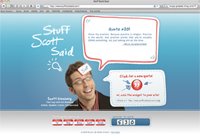 I don’t do drugs.
I don’t do drugs.
But if I did, I would make damn sure that my dealer was someone who regularly used – and enjoyed – the same drugs he sold to me.
THINK ABOUT IT: Wouldn’t you prefer to buy something from someone who’s tried it before?
And, look, I understand that you’re not a drug dealer. Anymore.
But you are a leader. Even if your job title doesn’t say so. Come on: Everyone’s a leader.
Which means, the question that matters is:
Are you smoking what you’re selling?
Rob Bell, pastor of Mars Hill Church and bestselling author of Velvet Elvis suggested the following:
“I cannot lead people somewhere I am not trying to go myself. I don’t need to have arrived, I don’t have to be perfect, but I do need to be on the path. Too many leaders have never descended into the depths of their own souls. They haven’t done the hard, difficult, gut-wrenching work of shining the bright lights on all the years of baggage and destructive messages.”
Now there’s a guy I’d buy drugs from.
Today we’re going to explore a list of strategies for making the experience people have of you more consistent, more approachable and more trustable.
1. Consistency – or lack thereof – affects everyone you encounter. You are on display. You are the result of your own pattern integrity. And your purpose as a leader isn’t a specific task – it’s the way you live your life.
My suggestion is to make your life a constant demonstration. To run a sequence of consistent, similar actions that reinforce to people, “Wow, this guy eats his own dog food.” After all, everything’s a performance and everybody’s watching. May as well play the character you know best – and don’t have to memorize lines for.
Remember: There’s nothing more influential than a living, breathing example. Are your organization’s leaders leading or lip servicing?
2. Surprise people with your impeccable word. Reliability is so rare – it’s become remarkable. Fortunately, you’re the kind of leader who (actually) delivers. That’s all people ask. Especially the ones who put their asses on the line for you.
They don’t want to look stupid.
They don’t want to lose their job.
They don’t want to be the first person to trust you.
They just want you to come through like you said you would.
Imagine that.
Ultimately, the secret is to set expectational clarity. To be more strategic about your intent. To know who you are and who you aren’t; what you’ll stand for and what you won’t stand for. Even if you have to hold a meeting for no reason other than to clarify mutual misapprehension. These are the contributing forces to building consistent reliability. Are you prolific in communicating expectations?
3. Lead with practices – follow with principles. The beliefs held in your heart are immaterial when compared to the actions taken with your feet. Fortunately, we live in a tangible world where concreteness is followable. Lesson learned: Leaders, who articulate values as verbs, win.
Take my Personal Constitution, for example. Every morning during my daily appointment with myself, I ritually revisit my list highest, non-negotiable core values, each of which contains its own sub-list of verbs and action-items. Here’s an excerpt:
Stern and uncompromising feet, commitment to boundaries through self-control and self-discipline; standing my ground without stepping on people’s toes, remaining flexible enough to bend when needed without compromising foundation, and never at the expense of another’s respect.
The cool part is: When you stand for something, decisions are obvious. That’s how you become a verb – by prioritizing orthopraxy (the right practices) over orthodoxy (the right beliefs). Remember: Values aren’t taught – they’re caught. Are you living your faith out in the world or lip servicing your beliefs from behind a desk?
4. Become the physical embodiment of your understanding. My mentor, Bill Jenkins, constantly reminds me: The best leaders eventually become the thing they’ve been teaching. He’s found – and I agree – that after a certain number of years, you just wake up one morning, look in the mirror and think to yourself:
“Wow. I am the message I’m been preaching. I am my own best case study. The word has become flesh.”
The hard part is remaining patient in learning to live physically what you know intellectually. To do so, consider becoming an expert at reflection upon and learning from your experiences.
The harder part is being consistent in letting your life enshrine what your lips proclaim. To do so, consider taking your own advice.
The hardest part is being (and staying) persistent in your efforts to become a living brochure of your own experience. To do so, consider (not) just having a name – but living your name.
Ultimately, when you start to deliver and demonstrate through every breath, you won’t need to sell or promise. Just breathe and infect. How well do you resemble what you worship?
5. Use yourself as your own case study. Approachable leaders know how to translate their unique experiences into relatable, digestible and universal messages that meet their people where they are. Your challenge is to design a system for drawing wisdom from every experience.
Consider asking three questions every time something happens to you: “What lessons could I learn from what just happened to me?” “How does this fit into my organization’s theory of the universe?“ and “What generic attributes of what just happened to me can be extracted and practically applied to my people?”
Whomever you serve as a leader (employees, associates, volunteers, members) recognize this: All you have to draw from is your unique experience. You’re not one of them. You can’t pretend to be one of them. And the moment you do, they’ll smell the veneer faster than a dog smells a fresh bag of Bacon & Cheese Snausages.
The only difference is, instead of drooling all over your leg, they’ll stop trusting you. How are you increasing your ROE, or Return on Experience?
6. Be not humiliated by having others see you truly. Immediately after sweating off five pounds during a typical Bikram Yoga class, I usually grab an ice-cold bottle of water and plop down on the sidewalk to recover. I call it a Reverse Sauna: The air is chilly, the breeze feels great and the concrete is cool on my legs. Can’t beat it.
And sure, I look a bit out of place doing so the parking lot. Then again, I’ve also been wearing a nametag twenty-four-seven for the past ten years. Kind of used to not fitting in by now.
Anyway, what fascinates me is Rick, the guy in my class who always gives me guff about it: “Scott, aren’t you worried that one of your clients will spot you out here?”
To which I respond, “Not really. My clients hire me because I’m a person – not just a personality. And when you’re sitting on the ground half-naked, sweating, steaming and exhausted – there’s no hiding out. And I have no problem with anyone seeing me like this.”
Lesson learned: Don’t back down from unguarded moments. Invite people to catch a glimpse of your naked truth, laid bear. After all, to truly live heroically is to commit to and act from the truest version of yourself – every day. How much loyalty are you sacrificing because you’re terrified of exposing a part of yourself you don’t like?
REMEMBER: Duplicity breeds distrust.
Shakespeare was right: Tis an ill cook that cannot lick his own fingers.
Your leadership challenge moving forward is as follows:
Match outer appearance and inner substance.
Align your onstage performance and backstage reality.
Make the message you preach the dominant truth of your life.
Give people the tools they need to build the world you envision.
Soon people from all around the world will form a line around the corner just to score a dime bag of your stuff.
LET ME ASK YA THIS…
Are you smoking what you’re selling?
LET ME SUGGEST THIS…
For the list called, “14 Things You Don’t Have to Do Anymore,” send an email to me, and I’ll send you the list for free!
* * * *
Scott Ginsberg
That Guy with the Nametag
Author, Speaker, Entrepreneur, Mentor
[email protected]
 Who’s quoting YOU?
Who’s quoting YOU?
Check out Scott’s Online Quotation Database for a bite-sized education on branding success!

 97%.
97%. Who’s quoting YOU?
Who’s quoting YOU? When I was in kindergarten, our class has a Tasting Party.
When I was in kindergarten, our class has a Tasting Party. Who’s quoting YOU?
Who’s quoting YOU?